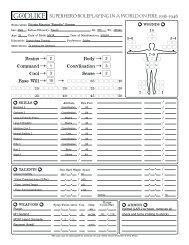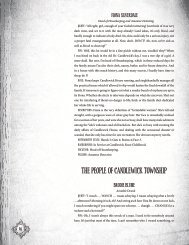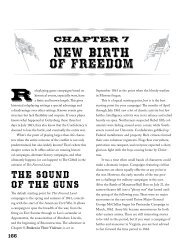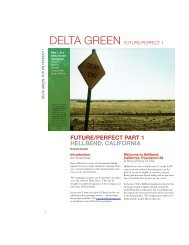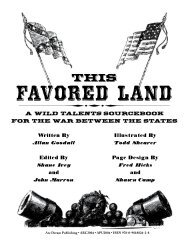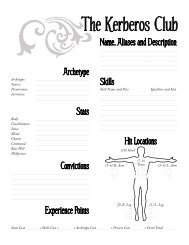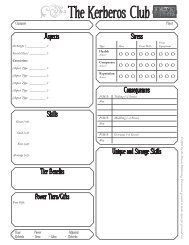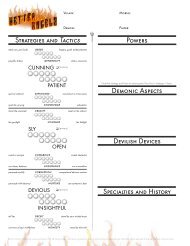Untitled - Arc Dream Publishing
Untitled - Arc Dream Publishing
Untitled - Arc Dream Publishing
You also want an ePaper? Increase the reach of your titles
YUMPU automatically turns print PDFs into web optimized ePapers that Google loves.
Monsters<br />
and Other Childish Things
Monsters and Other Childish Things is a roleplaying game based on <strong>Arc</strong> <strong>Dream</strong> <strong>Publishing</strong>’s WILD TALENTS: Superhero<br />
Roleplaying in a World Gone Mad. Written by Benjamin Baugh, © 2007. Illustrated by Robert Mansperger, © 2007.<br />
“Madison’s Doodles” by Rebecca Ivey, © 2007. Edited by Kevin Pezzano. Copy editing and page design by Shane Ivey. The<br />
One-Roll Engine is © Greg Stolze. Wild Talents is © Dennis Detwiller and Greg Stolze. All rights reserved.<br />
No part of this publication may be reproduced in any way without the express written consent of its owner. Permission<br />
granted to print one copy for personal use only. If you get a free copy in print or download, please pay for it; our own little<br />
monsters are hungry, too.<br />
Special thanks to our playtest GMs and all their players: Daniel Bayn, Clifford Morton, Hobbie Regan, Rowdy Scarlett and<br />
Simon Stroud.<br />
Learn more about Wild Talents and the One-Roll Engine online:<br />
http://www.arcdream.com/wildtalents<br />
<strong>Arc</strong> <strong>Dream</strong> <strong>Publishing</strong><br />
ARC2001 • May 2007<br />
ISBN-10: 0-9727782-7-6<br />
ISBN-13: 978-972778276-5
Introduction ............................................................................... 1<br />
What Do I Need To Play? ..................................................... 1<br />
Thanks Where It’s Due.......................................................... 2<br />
Characters ................................................................................... 2<br />
Stats and Skills ........................................................................ 2<br />
Rolling Dice ............................................................................. 2<br />
Relationships: The Ties That Bind ...................................... 3<br />
Character Creation Summary ............................................. 4<br />
Character Creation Example ............................................... 4<br />
Group Creation ...................................................................... 5<br />
Conflict ......................................................................................... 5<br />
Conflict Rounds ..................................................................... 5<br />
Hit ‘Location’ .......................................................................... 5<br />
Dodging and Defending ....................................................... 5<br />
Damage: Shocks and Scars ................................................... 6<br />
Running Away ......................................................................... 7<br />
A Conflict Example ............................................................... 7<br />
Monsters ...................................................................................... 8<br />
The Basics ................................................................................ 9<br />
Monster Bonding ................................................................... 9<br />
Building Your Very Own Monster ....................................10<br />
When Monsters Fight People ............................................12<br />
When Monsters Fight Monsters .......................................13<br />
Yummy, Yummy Relationships ..........................................13<br />
Monster Creation Example ................................................13<br />
Kicking Butt and Taking Names .......................................14<br />
Character Advancement .......................................................15<br />
The Janitor’s Closet: Junk for GMs .....................................15<br />
Grade Level ...............................................................................15<br />
Elementary School ...............................................................16<br />
Junior High ............................................................................16<br />
High School ...........................................................................16<br />
Antagonists ...............................................................................16<br />
The Creepy Guy ....................................................................16<br />
The Excruciators ..................................................................17<br />
Mad Science Teacher ..........................................................19<br />
M.I.B. ......................................................................................20<br />
A Wizard (Wannabe) ..........................................................21<br />
Contents<br />
Everybody Else .........................................................................22<br />
Administrator .......................................................................22<br />
Bully .......................................................................................22<br />
Cop ..........................................................................................23<br />
Your Crush ............................................................................23<br />
Drunken Clown ....................................................................23<br />
Fashion Nazi .........................................................................23<br />
Gang Banger..........................................................................24<br />
Geek ........................................................................................24<br />
Gym Coach............................................................................25<br />
Hood .......................................................................................25<br />
Janitor .....................................................................................25<br />
Jock .........................................................................................26<br />
Older Brother........................................................................26<br />
O’Malley the Anti-Drug Dog .............................................26<br />
Parent .....................................................................................27<br />
Paparazzi................................................................................27<br />
Random Crazy ......................................................................27<br />
Teacher ...................................................................................28<br />
Trenchcoat Mafioso ............................................................28<br />
Younger Sister .......................................................................29<br />
Campaign Jumpstart: Welcome to Pluto .........................29<br />
Campaign Jumpstart: The XMFL .......................................30<br />
Campaign Jumpstart: Ugly Secrets ....................................31<br />
Being Somebody: Play-Ready Characters .......................32<br />
Tommy Mezlowski ..............................................................32<br />
Madison Kate Sinclair-Stevenson .....................................33<br />
Ralph ‘Dog’ Jones .................................................................35<br />
Lucy Awai ..............................................................................36<br />
Daniel Jackstone ...................................................................37<br />
Kids, Monsters and Wild Talents .......................................38<br />
Optional Rules ......................................................................38<br />
Characters .............................................................................38<br />
Monsters ................................................................................38<br />
One-Roll Gadgets ...................................................................39<br />
Interpersonal Conflict Generator .....................................39<br />
One-Roll Monster Summoning ........................................40
Introduction<br />
Monsters and Other Childish Things is a roleplaying game<br />
about kids with pet monsters. Like childhood, its tone is<br />
intended to be in parts whimsical and horrific.<br />
Kids from age ten up to early teens find themselves<br />
bonded to horrors from beyond time and space who want<br />
to be their friends, play fun games, and devour the souls of<br />
their enemies.<br />
The adult world is still reeling from the revelation of<br />
monsters, and many can’t help wondering, “Why now?”<br />
But while it’s about kids, this game isn’t really meant<br />
to be played by kids. Gamer kids could totally handle the<br />
mechanics, but I think mostly adults will appreciate the<br />
gallows humor and the occasional grownup themes.<br />
What Do I Need To Play?<br />
You need access to a full and proper One-Roll Engine<br />
(ORE) game to get the most out of Monsters and Other<br />
Childish Things.<br />
It is based primarily on Wild Talents, a superhero game<br />
that does a lot more than superheroes, but without too<br />
much squinting and head-scratching you could use Godlike,<br />
Nemesis, or Greg Stolze’s Reign.<br />
If you use Reign, you’ll also get a shiny gold star for incorporating<br />
organizations and companies into your Monsters<br />
game—gangs, clubs, school government, and so on.<br />
Beyond that, you just need all the rest of the things<br />
you’d need for an ORE game: a pile of 10-sided dice, paper,<br />
pencils, and friends.
Thanks Where It’s Due<br />
Thanks to my wife Sarah, who puts up with my crap.<br />
Thanks to my daughter Adeline, who was willing to sleep<br />
strapped to my chest while I wrote the bulk of this.<br />
Thanks to Shane Ivey and Dennis Detwiller for busting<br />
their humps making Wild Talents live.<br />
Thanks to Greg Stolze, who designed the One-Roll En-<br />
Characters<br />
Characters in Monsters and Other Childish Things are<br />
pretty simple. They have stats, they have skills, and—most<br />
important of all—they have Relationships. Of course, they<br />
also have monsters. We’ll create them later on.<br />
Stats and Skills<br />
If you don’t know what stats and skills are, take a second<br />
and read about them in the ORE game of your choice.<br />
Stats are broad capabilities, the kinds of things you’re<br />
good at. Skills are more specialized things you actually<br />
know how to do. Each stat and skill gets a rating in dice.<br />
Kids have the following stats: Feet, Guts, Hands, Attention<br />
and Wits. Each stat starts at 1 die, and you have 10<br />
more stat dice to put where you like.<br />
Under each stat, you’ve got some skills. Each skill starts<br />
at zero, but you have 15 skill dice to put where you like.<br />
No single stat or skill have more than five dice.<br />
As in other ORE games, roll dice equal to your STAT +<br />
SKILL to do something—so if you want to climb a tree, roll<br />
your Feet dice and your P.E. dice together. But see Relationships<br />
(page 3) for ways to get more lovely dice.<br />
Feet<br />
Moving your whole body without looking like a dork.<br />
P.E.: Running, jumping, climbing trees.<br />
Kicking: Putting the sneaker where it’ll do the most good.<br />
Dodging: Getting out of the way.<br />
Special and Unique Snowflakes<br />
You’ve just got to be different and special, eh? Well, if<br />
there’s something you want to be good at that doesn’t fall<br />
under the normal skills, just ask the GM if you can make<br />
up a new one.<br />
It’s totally cool to have a kid with Mad L33T Hacking<br />
Skillz, or one who knows how to Skin a Buck. Maybe one<br />
who’s Got a Learner’s Permit and can sometimes swipe<br />
his Mom’s keys would be useful in a game.<br />
Or if you’re trying to be totally goth, Dark Secrets of<br />
the Elder Gods might come in handy. Rather than writing<br />
“Mrs. Randy McNuttly” over and over on your Civics<br />
notebook, you can write the seventeen forbidden names<br />
of Shug-Ligo’wa the Wetter of Beds.<br />
gine game system, which never fails to lure out the system<br />
monkey in me like a whole bunch of golden ripe bananas.<br />
Thanks to Robert Mansperger, who worked his magic<br />
on this and whose style now illustrates my brain (replacing<br />
Edward Gorey, whose illustrations I originally imagined).<br />
And thanks to Kevin Pezzano, who did a masterful job<br />
of keeping me from looking like a jerk with my editing and<br />
organization.<br />
Guts<br />
How tough and dogged you are. Also, the most likely place<br />
someone’s going to punch you.<br />
Wind: Health, breath, and fitness.<br />
Courage: Standing up to bullies and Eldritch Horrors<br />
from Beyond Space and Time.<br />
Wrestling: Grabbing hold and squeezing and not letting<br />
go till the other guys says you’re the boss of him.<br />
Hands<br />
Your fine dexterity and movement, so you don’t pick your<br />
eye instead of your nose.<br />
Shop: Working with your hands.<br />
Punching: Socking ’em in the chops.<br />
Blocking: Using a thing to stop a thing from hitting you<br />
in the thing.<br />
Attention<br />
How much of what you see and hear actually gets through<br />
your skull.<br />
Out-Think: Brains instead of brawn.<br />
Remember: Book learnin’ and keeping up with details.<br />
Notice: Spotting both the forest and the trees, and the<br />
squirrels and the Bigfoots, too.<br />
Wits<br />
How cool, clever, and sneaky you can be. Everyone loves a<br />
smart-aleck.<br />
Charm: Winning friends and influencing teachers.<br />
Putdown: Ragging on the other guy’s mom.<br />
Connive: Lying and other vitally-deceptive kid skills.<br />
Rolling Dice<br />
Dice are rolled according to the ORE standard described in<br />
Wild Talents, pages 8 through 12. Add the values of a stat<br />
and a skill together and roll that number of dice. Look for<br />
matching dice in the roll.<br />
So if you need to remember what the weird kid at the<br />
mall was wearing and you have 3d in Attention and 2d in<br />
Notice, you’d add them together and roll five dice.<br />
Width and Height<br />
If any of the dice come up matching each other—a pair of<br />
fives, maybe, or three ones—you succeed. If not, you fail.<br />
monsters and other childish things
The number of dice that come up with the same value<br />
is called the width of the roll. If you roll three five’s, for<br />
instance, that’s a width of three.<br />
The value of the dice that match each other is called the<br />
height of the roll. So with those three fives, the height is five.<br />
We abbreviate rolls as WIDTH x HEIGHT, so three fives<br />
are 3x5. A pair of eights would be 2x8. No, that’s not multiplication.<br />
It just means “thee by five” or “two by eight.”<br />
Width usually indicates speed and (for physical actions<br />
like fighting) raw power. Height usually indicates quality,<br />
accuracy and finesse. So if one player rolls 3x5 and the<br />
other rolls 2x8, the player with the width 3 would go first,<br />
but the player with the height 8 would act with more accuracy<br />
and subtlety.<br />
Which is more important, width or height? That depends<br />
on the circumstances. If you’re in a race at a track<br />
meet, width is most important because width means<br />
speed. If you’re in a race across a junk yard, height is important,<br />
too, because the GM will probably say that if your<br />
roll’s height is too low you trip over some garbage.<br />
Width and height are each other’s tiebreakers. If height<br />
is the same, use width as the tiebreaker. If width is the<br />
same, use height as the tiebreaker. If they’re both the same,<br />
use the total number of dice in the dice pools as the tiebreaker.<br />
If those are the same, too, it’s up to the GM.<br />
When to Roll and What to Roll<br />
As a tip for the GM, it’s usually a good idea to require a<br />
roll only if an action sounds really tricky. If you think an<br />
ordinary kid could do it without too much trouble, don’t<br />
bother asking for a roll, because it’ll just annoy everyone if<br />
the roll fails.<br />
A final note: You never roll more than 10 dice. If you<br />
have more than that in a dice pool for some reason, you<br />
can use the excess dice to offset circumstances that cause<br />
you to lose dice, but you can’t actually roll more than 10.<br />
Relationships: The Ties That Bind<br />
Even isolated malcontents have relationships of a sort.<br />
It’s wired in—well, wired into most people—to form ties<br />
with others. Channels of emotional reciprocity. Empathy.<br />
Anticipation.<br />
Monsters really love this about humans—especially<br />
kids—because to a monster, a relationship is like a chocolate<br />
and meth milkshake. It energizes them, makes them<br />
powerful, feeds them up nice and plump. Monsters eat<br />
relationships.<br />
A relationship is dice pool that describes a personal attachment<br />
to something or someone, like “Dad 3,” with three<br />
dice, or “Jenny 2” with two dice, or “My Blankie 5” with five<br />
dice. You can have a relationship with anything, as long as<br />
you can imagine just how that relationship might work.<br />
Adding Relationship Dice<br />
Kids really benefit from Relationships, because if motivated<br />
by one they can use the Relationship score to bulk<br />
monsters and other childish things<br />
out their generally puny dice pools. If a Relationship would<br />
somehow improve your odds of success, you can add some<br />
or all of your Relationship dice to your dice pool before<br />
rolling. If you’re in a fight, you’ll probably hit a lot harder<br />
when someone is ragging on your Mom (4d).<br />
There’s a risk, though. When you put your heart on your<br />
sleeve, someone’s going to knock it off, kick dirt on it, and<br />
then shove it down your throat.<br />
If, even with the Relationship dice added in, you still fail<br />
your roll, then your Relationship takes a Shock. A Shock is<br />
a special kind of hit that a Relationship takes—it’s not the<br />
same as the Shock damage that characters take when they<br />
get punched.<br />
Each Shock reduces your Relationship by one die, indicating<br />
tension, resentment or something else. This colors<br />
how you interact with the object of your relationship, and<br />
how he/she/it interacts with you.<br />
A Relationship that’s been Shocked is tense, and everyone<br />
involved knows it. One that’s Shocked down to nothing<br />
is in real Crisis, and you need to do something about it<br />
immediately or it’ll go south fast, causing the Relationship<br />
to become permanently weakened.<br />
You can get dice back in a Shocked relationship, but it<br />
takes some work.<br />
Quality Time<br />
Dealing with a Shocked relationship requires you to do<br />
something to fix the problem: Quality Time. You have to<br />
take active steps to make things better. You think your<br />
Mom is going to apologize to you? Ha! It’s all on you to<br />
make it OK again.<br />
You can call for a scene where you can address problems<br />
in your Relationships whenever you like, or seize the<br />
opportunity if an appropriate scene happens to pop up<br />
during the game. The GM will try and work the scene into<br />
any big plot he has going on.<br />
Quality Time requires a dice roll with a difficulty equal<br />
to 4+X, where X is the number of Shocked dice that have<br />
been done to that Relationship. That means if you have<br />
three Shocked dice, you roll at difficulty 7: Your roll’s<br />
height must be 7 or higher to suceed.<br />
If your Quality Time roll succeeds, your Relationship<br />
gains width in dice back—so if you roll a 2x5, you get back<br />
two Relationship dice. But you can’t increase the Relationship<br />
beyond what it was before you messed it up. To do<br />
that you need character advancement (see page 15).<br />
Which Roll?<br />
The stat and skill you use for this roll depends on the<br />
Relationship and the actions you take to try and heal it.<br />
Throwing the ball around with Dad might require a Feet<br />
+ P.E. roll, while playing poker with your amiable drunk<br />
uncle might be Wits + Connive.<br />
The only restriction is that you can’t use the same stat<br />
+ skill pool twice in a row when using Quality Time. Each<br />
attempt to recover dice in the Relationship requires a different<br />
stat + skill.




